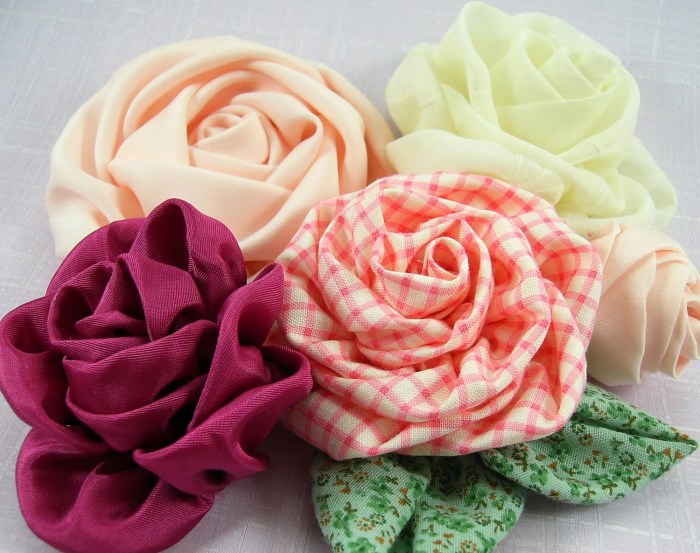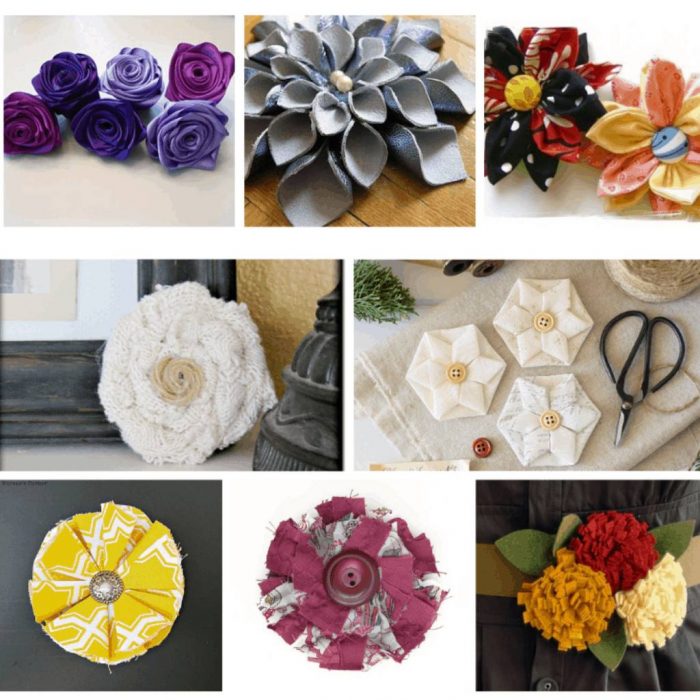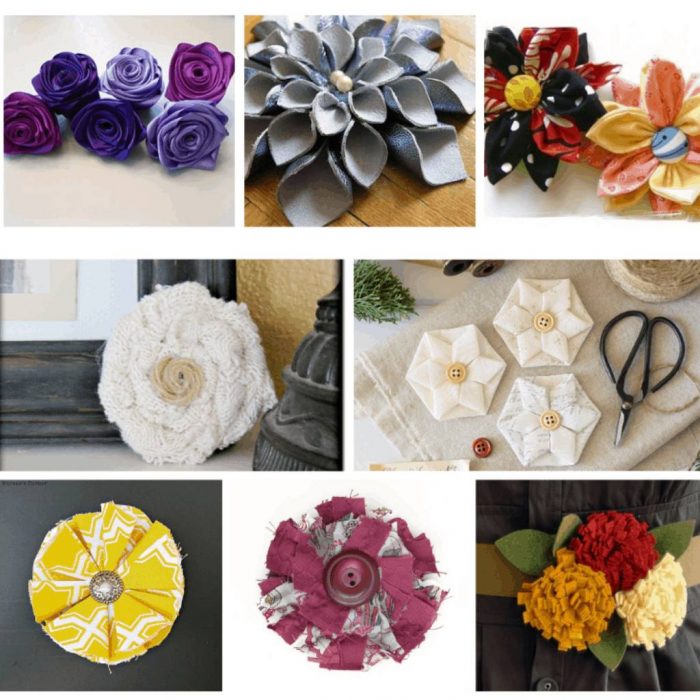DIY cloth flowers are gaining popularity as a creative and personalized way to add beauty to homes, weddings, and even fashion. The appeal lies in the ability to create unique floral arrangements using fabric, offering a delightful alternative to traditional silk or paper flowers.
From delicate roses to vibrant sunflowers, the possibilities are endless. With a little creativity and some basic materials, anyone can craft stunning cloth flowers that add a touch of elegance and charm to any occasion.
Basic Techniques and Methods
Creating cloth flowers is a delightful and rewarding craft that allows you to express your creativity and add a touch of elegance to your surroundings. With a few basic techniques and materials, you can create a wide variety of beautiful flowers to enhance your home decor, personalize gifts, or even create stunning floral arrangements.
Creating a Simple Cloth Flower
To create a simple cloth flower, you’ll need fabric, scissors, needle and thread, and a button or bead for the center.
- Cutting the Petals: Start by cutting out petal shapes from your chosen fabric. You can use a template or freehand it. Experiment with different sizes and shapes to create a variety of flower styles.
- Shaping the Petals: Once you have your petals cut out, you can shape them by gently stretching the edges or using a hot iron to create soft curves. You can also use a fabric marker to add details like veins or spots.
- Assembling the Flower: To assemble the flower, simply stitch the petals together in a spiral pattern, starting from the center and working your way outwards. You can use a needle and thread or a hot glue gun to secure the petals.
- Adding the Center: Once the petals are assembled, attach a button or bead to the center of the flower to create a focal point.
Creating Realistic Flower Textures and Patterns
Creating realistic flower textures and patterns can add a touch of authenticity and beauty to your cloth flowers.
- Embossing: Use a heat embossing tool to create raised textures on the petals. This can be used to mimic the veins of a leaf or the ridges of a rose petal.
- Fabric Painting: Use fabric paints to add color, patterns, and details to your petals. You can use a brush, sponge, or even a toothpick to create different effects.
- Embroidery: Add intricate details to your petals with embroidery stitches. This can be used to create realistic flower patterns or simply add a touch of embellishment.
- Decoupage: Use decoupage techniques to add textures and patterns to your petals. This can be done by applying layers of tissue paper, fabric scraps, or even dried flowers.
Methods for Attaching Cloth Flowers
There are several methods for attaching cloth flowers to stems or other surfaces.
| Method | Description | Pros | Cons |
|---|---|---|---|
| Wire Stem | Attach the flower to a wire stem using glue or thread. | Durable, versatile, allows for bending and shaping. | Can be time-consuming, requires additional materials. |
| Hot Glue | Use a hot glue gun to attach the flower to a stem or surface. | Fast and easy, suitable for small flowers. | Can be messy, may not be as durable as other methods. |
| Sewing | Sew the flower to a stem or surface using needle and thread. | Strong and secure, suitable for larger flowers. | Can be time-consuming, requires sewing skills. |
Applications and Uses of DIY Cloth Flowers
DIY cloth flowers offer a versatile and creative way to add a touch of elegance and beauty to various aspects of life. They can be used for a wide range of purposes, from decorating special events to crafting unique gifts and fashion accessories.
Wedding Decorations
DIY cloth flowers are a popular choice for wedding decorations due to their affordability, durability, and ability to be customized to match the wedding theme. They can be used to create stunning centerpieces, bouquets, garlands, and even to adorn the wedding cake. The ability to create unique flower designs and color combinations allows couples to personalize their wedding decor and create a truly unforgettable atmosphere.
Home Decor, Diy cloth flowers
Beyond weddings, DIY cloth flowers can transform any home into a more inviting and stylish space. They can be used to create beautiful wreaths, wall art, and even decorative pillows. The flowers can be incorporated into existing home decor or used to create a new theme or style. Their versatility allows them to be used in various rooms, from the living room to the bedroom, adding a touch of natural beauty and elegance.
Fashion Accessories
DIY cloth flowers are also a fantastic way to add a unique touch to fashion accessories. They can be used to create beautiful headbands, corsages, and boutonnieres. These accessories can be worn for special occasions or as everyday fashion statements. The possibilities are endless, with various styles, colors, and sizes of cloth flowers available to create personalized and eye-catching accessories.
Craft Projects
DIY cloth flowers can also be incorporated into various craft projects. They can be used to embellish greeting cards, scrapbook pages, and even to create unique jewelry. The ability to create different sizes and shapes of flowers allows for endless creative possibilities, making them an ideal material for crafting projects.
Gift-Giving
DIY cloth flowers make thoughtful and personalized gifts for any occasion. They can be incorporated into gift baskets, used to decorate gift boxes, or even presented as a standalone gift. The ability to customize the flowers to the recipient’s taste makes them a truly special and memorable gift.
Preserving and Caring for DIY Cloth Flowers

DIY cloth flowers, with their vibrant colors and delicate textures, can add a touch of elegance to any space. To ensure that your creations retain their beauty and longevity, it’s crucial to understand the proper methods for preserving and caring for them.
Cleaning and Protecting Cloth Flowers
Regular cleaning is essential to keep your cloth flowers looking their best. Dust and debris can accumulate over time, dulling their appearance.
- Gently brush away dust using a soft-bristled brush. Avoid using harsh chemicals or abrasive materials that could damage the fabric.
- For more thorough cleaning, consider using a vacuum cleaner with a soft brush attachment. Set the vacuum to low suction to prevent damage to the delicate petals.
- If your cloth flowers are made with delicate materials, consider using a damp cloth to gently wipe away dust and dirt. Ensure the cloth is wrung out thoroughly to avoid soaking the fabric.
Storing DIY Cloth Flowers
Proper storage is crucial for maintaining the shape and vibrancy of your cloth flowers.
- Store your flowers in a cool, dry place, away from direct sunlight and moisture. Sunlight can fade the colors of your flowers, while moisture can cause mold and mildew.
- Consider using airtight containers or boxes to protect your flowers from dust and insects.
- If you are storing your flowers in a display case, ensure the case is well-ventilated to prevent moisture buildup.
Displaying DIY Cloth Flowers
Displaying your cloth flowers thoughtfully can enhance their beauty and create a stunning visual impact.
- Use vases, jars, or other decorative containers to showcase your flowers. Choose containers that complement the style and colors of your flowers.
- Consider using floral wire or tape to create arrangements and bouquets. This allows you to experiment with different shapes and designs.
- Incorporate your cloth flowers into wreaths, garlands, and other decorative elements. This can add a touch of elegance to your home decor.
Advanced Techniques and Projects

Taking your DIY cloth flower skills to the next level involves exploring more intricate techniques and incorporating them into unique projects. This section will delve into advanced techniques, explore ways to use different fabric textures and colors for artistic designs, and provide ideas for crafting complex flower arrangements and incorporating DIY cloth flowers into larger projects.
Using Different Fabric Textures and Colors
The beauty of cloth flowers lies in the ability to experiment with various fabrics, each adding its own unique character to the final creation. Using different textures and colors allows for artistic expression and creates a wide range of possibilities.
- Silk and Satin: These fabrics are known for their smooth, luxurious feel and vibrant colors, lending themselves to elegant and sophisticated flowers. They drape beautifully, adding a touch of elegance to your creations.
- Cotton and Linen: These fabrics offer a natural and rustic charm, ideal for creating flowers with a vintage or cottagecore aesthetic. Their textured surfaces provide a unique visual appeal.
- Velvet: The plushness and rich color of velvet can be used to create dramatic and luxurious flowers, adding a touch of opulence to any project.
- Lace and Net: These delicate fabrics add a touch of romance and femininity to your floral designs. Their intricate patterns and airy textures create a sense of lightness and grace.
- Felt: Felt is a versatile material that can be used to create a wide range of flower shapes and textures. Its ability to hold its shape makes it ideal for creating petals and leaves with intricate details.
Creating Complex Flower Arrangements
Once you’ve mastered the basic techniques of cloth flower making, you can move on to crafting more intricate and complex arrangements. These arrangements can be used to adorn your home, as centerpieces for special occasions, or as unique gifts.
- Layered Arrangements: Create depth and dimension by layering different types of cloth flowers with varying sizes and textures. This technique allows you to build a visually appealing arrangement that captures the beauty of a natural bouquet.
- Mixed Media: Incorporate other materials such as dried flowers, branches, or beads to create a truly unique and eclectic arrangement. This allows you to play with different textures and colors, adding a touch of whimsy and personality to your creations.
- Sculptural Arrangements: Use cloth flowers to create three-dimensional sculptures. This technique involves arranging the flowers in a specific pattern, creating a sense of movement and flow. You can use wire or other materials to support the structure of your sculpture.
Incorporating DIY Cloth Flowers into Larger Projects
The versatility of DIY cloth flowers extends beyond standalone arrangements. They can be incorporated into a variety of larger projects, adding a touch of beauty and personalization.
- Wreaths and Garlands: Use cloth flowers to create festive wreaths for holidays or seasonal decorations. You can also create garlands to add a touch of color and elegance to your home decor.
- Headbands and Hair Accessories: Craft delicate flower headbands or hair clips to add a touch of whimsy to your everyday style. You can also use cloth flowers to create beautiful bridal hair accessories.
- Clothing and Accessories: Add a unique touch to your wardrobe by embellishing clothing or accessories with DIY cloth flowers. This can range from simple embellishments on a handbag to more intricate floral patterns on a dress.
- Home Decor: Use cloth flowers to create custom lampshades, pillow covers, or even wall art. The possibilities are endless when it comes to incorporating these beautiful handmade flowers into your home decor.
The world of DIY cloth flowers offers a captivating blend of creativity, resourcefulness, and artistry. Whether you’re a seasoned crafter or a curious beginner, exploring the world of cloth flowers is an enriching experience. From the simple joy of creating a single bloom to the intricate beauty of a complex arrangement, the journey of crafting with fabric is sure to spark your imagination and leave you with a sense of accomplishment. So, gather your materials, let your creativity blossom, and embark on your own journey of crafting beautiful and unique cloth flowers.
DIY cloth flowers are a fun and affordable way to add a touch of whimsy to your home décor. If you’re looking for a way to save money on cleaning supplies, you might want to try making your own dish soap diy. Once you’ve tackled your cleaning chores, you can return to your floral creations and use your homemade dish soap to wash any stains off your hands or fabric scraps.

